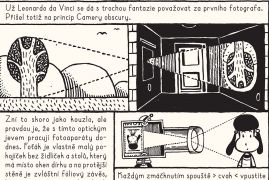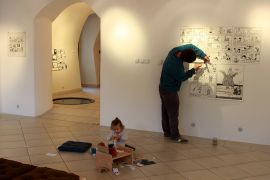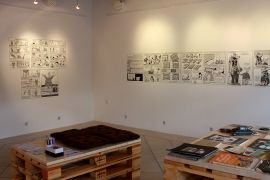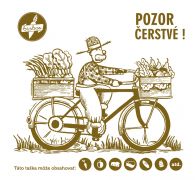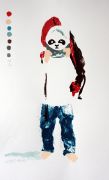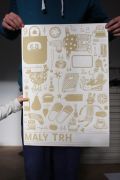They form a pair. Martin Krkošek and Pavla Krkošová Byrtusová, partners both in their personal and professional lives, live in Návsí u Jablunkova, a stone’s throw away from the Slovakian border, just between Třinec and Žilina.
Návsí is spread out along the main road, and cannot boast anything akin to a city center, but is instead surrounded by deep forest on all sides. In the workshop Uutěrky, everything centers on the home-made screen prints which Krkošek and Byrtusová have been making for the last six years.
“We are a self-supported screen printing workshop. We try to do things at low cost, but with that much more devotion. We are sometimes pleased with the flaws which occur, as they are really an integral part of the whole process. We do not like to call our customers ‘clients,’ and are glad to make friends with them, which usually happens naturally anyway,” says Krkošek.
Apart from screen printing, Krkošek also devotes his time to book illustrations, graphic design, animation and teaching. Byrtusová paints, draws, photographs, and writes texts for various publications. They are both inspired by work in the garden, working with children, the art world, local lore and, of course, their beautiful surroundings.
Krkošek says that their clients (a.k.a. _friends)) come to them on their own: “We usually have similar people find us, people with whom we click – like bands making an LP. They sometimes do some of the work themselves, and I help them print it, cut it or glue it. The product is, from the very outset, all done in a DIY fashion.” For example, this is how they collaborate with the Analog Freaks record label. Another long-term and important partner for Uutěrky, the Slovakian Stanica, is a vibrant cultural center situated at the Žilina-Záriečie train station. That is also where Byrtusová and Krkošek have their screen printing workshop at the moment, and Krkošek regularly goes there to teach creative courses. For these he makes various worksheets and teaching aids which are mini art pieces in themselves. In Slovakia, they also collaborate with the Periférny Centra, for example, a rural cultural organization located in Dúbravice u Banské Bystrice.
“If we had to sum it up, we work in services – that is screen printing, graphic works, illustration, book binding, photography and, let’s say, pedagogy,” says Krkošek, explaining the work of Uutěrky. Byrtusová adds: “We enjoy handcrafting and slow work in the workshop. At home, we have a garden, and everything takes place at a natural pace. We want to keep it that way, so we will always be able to put food on the table, but also keep enjoying the work.”
Apart from providing services, the Uutěrky couple also work on their own projects, such as original publications (like Listování, Byrtusová’s poetic visual essay which connects gardening and the inspiration gained from Martin Ryšavý’s Siberian travelogue), collections (like KABINETbotanika, a colorful and diverse collection consisting of various contributions), poetry and nursery rhymes from around the region of Jablunkov (bojtky), and the newly published Pidiskicák. They also print on textiles, such as shirts, handkerchiefs and bags.
Sometimes people invite them to teach book binding, origami making and embroidery. At the moment, they would like to publish an encyclopedia which was originally intended for educational workshops at Žilina’s Stanica. The various entries are take the form of comics, in which a cricket, a rat, and some salamanders discuss various types of art. The book will be called (Ne)všední den pana Stana, or (Mr. Stan’s (Extra)Ordinary Day) and two years ago, they presented illustrations for the encyclopedia at an exhibition in Týn nad Vltavou.
They are now considering moving their workshop to Návsí, which is possible due to the friendly treatment they get from the local municipality who support them in various ways. Krkošek decorated the local elementary school with his illustrations, and Byrtusová has also photographed the local kindergarten children. They were recently commissioned to draft the design for the pedestrian underpass in Návsí.
Byrtusová laughs that they are like “some sort of decorating band,” while Krkošek comments that the various collaborations have been going well because they “try to do things somehow naturally, and it seems to be working.”
Lenka Dolanová
